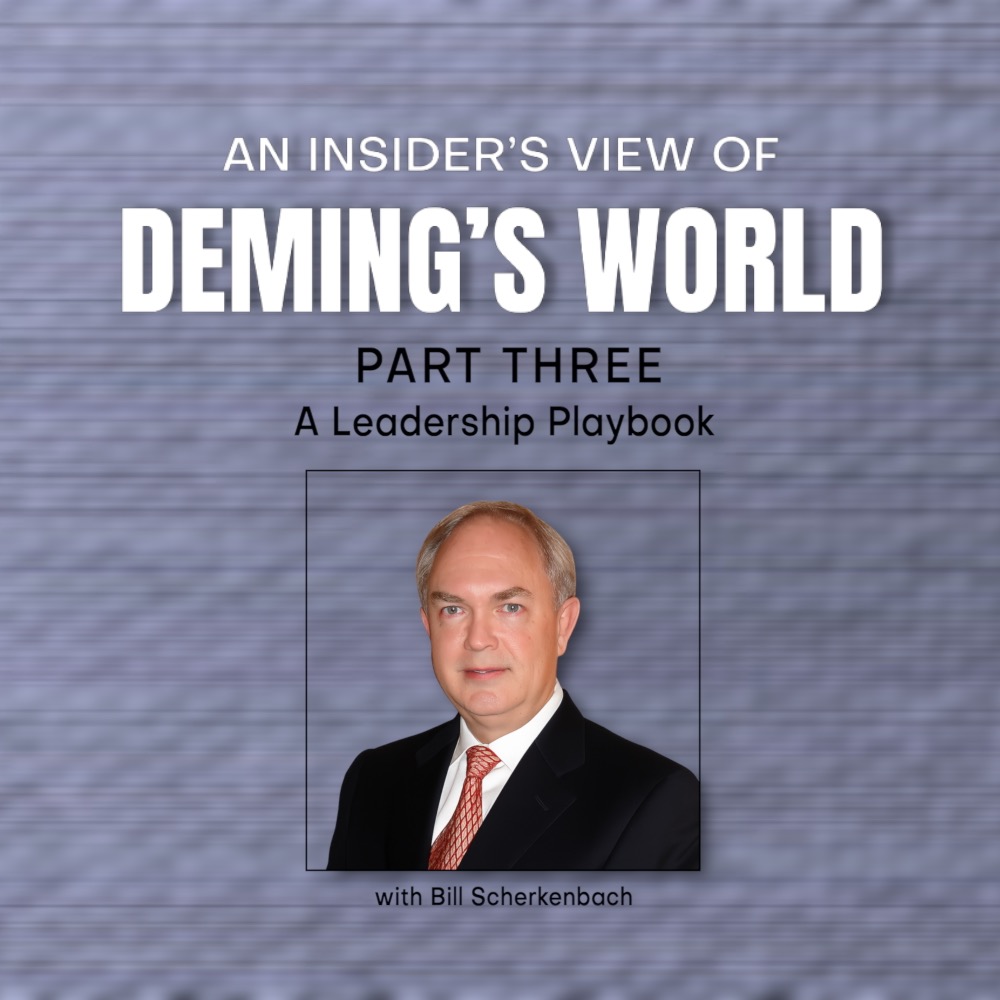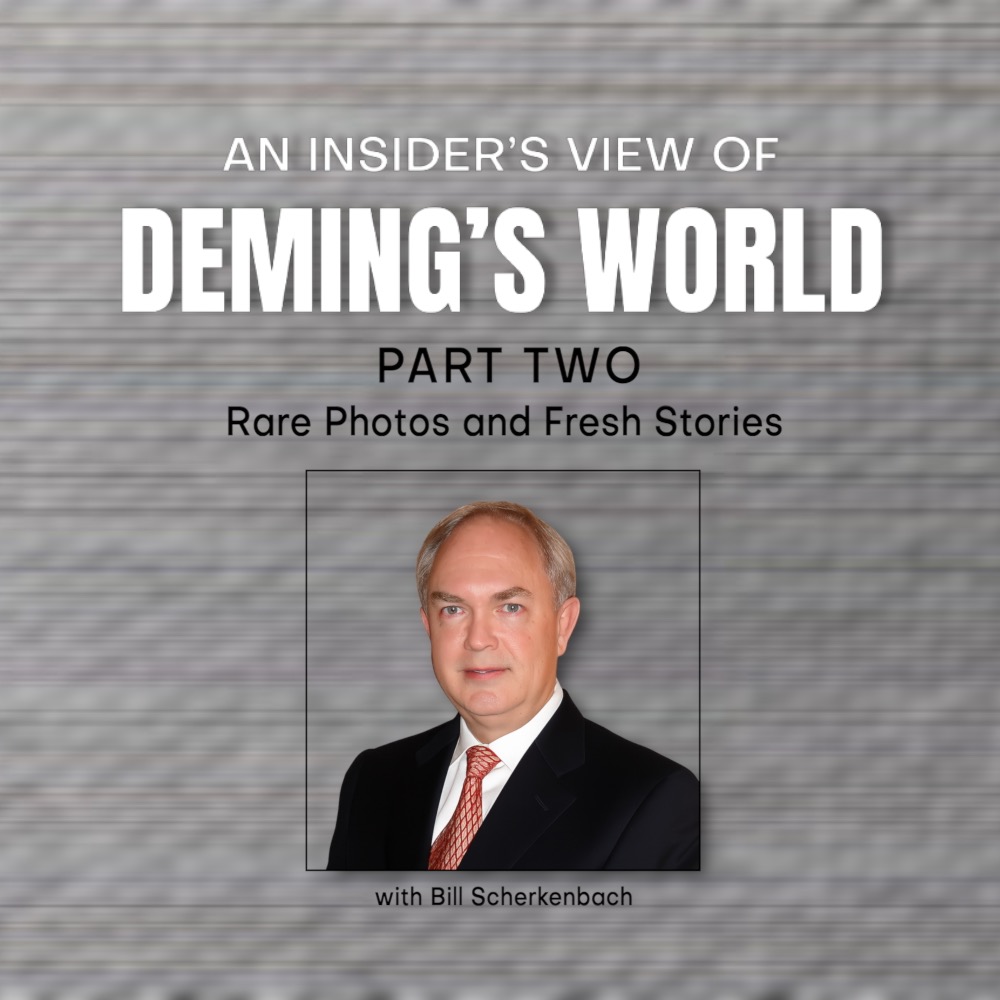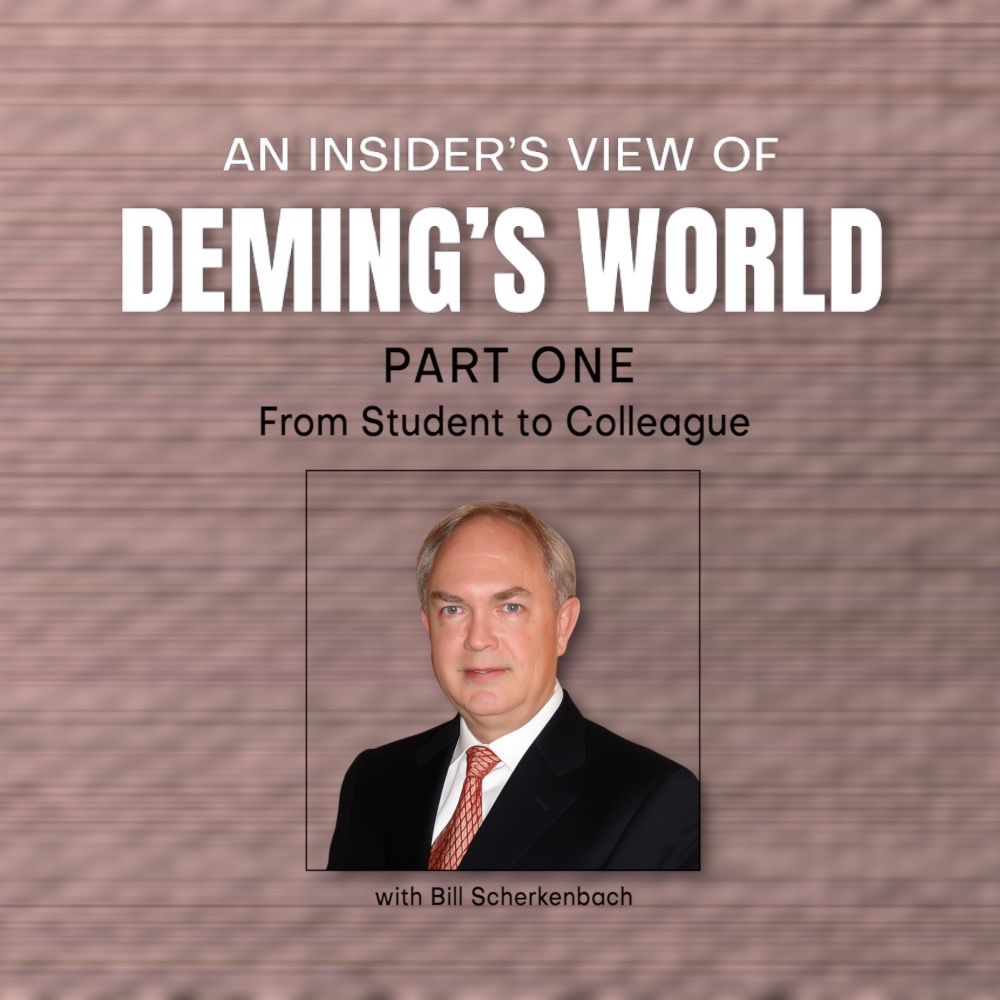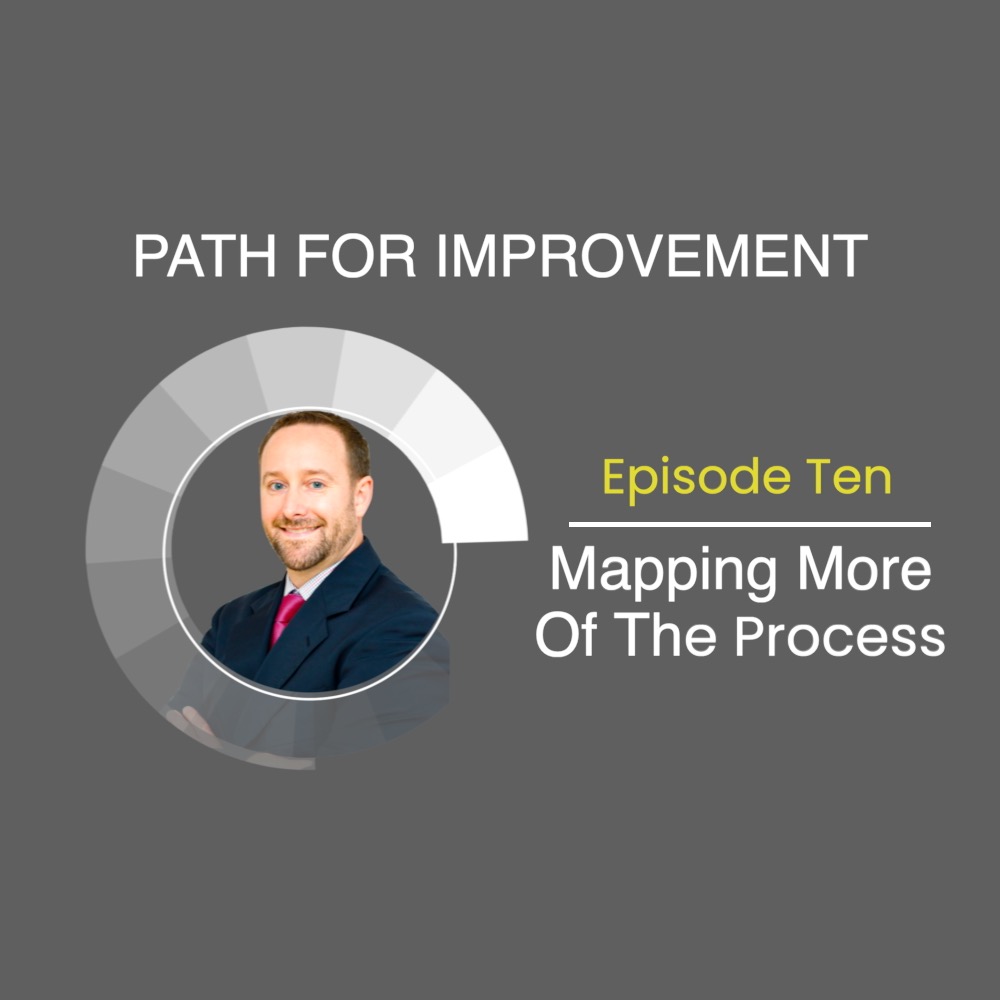A Leadership Playbook: An Insider's View of Deming's World (Part 3)
Description
Great leaders know there's no one-size-fits-all formula. In this episode, Bill Scherkenbach and Andrew Stotz discuss practical lessons on how to connect with people on physical, logical, and emotional levels to truly get things done. Discover why balancing "me" and "we" is the secret to lasting results—and why empathy might be your most powerful leadership tool. Tune in now and start rewriting your own leadership playbook. (You can view the slides from the podcast here.)
TRANSCRIPT
0:00:02 .1 Andrew Stotz: My name is Andrew Stotz, and I'll be your host as we dive deeper into the teachings of Dr. W. Edwards Deming. Today, I'm continuing my discussion with Bill Scherkenbach, a dedicated protégé of Dr. Deming since 1972. Bill met with Dr. Deming more than a thousand times and later led statistical methods and process improvements at Ford and GM at Deming's recommendation. He authored The Deming Route to Quality and Productivity at Deming's behest, and at 79, still champions his mentor's message, "learn, have fun, and make a difference." And the episode today is Getting Things Done. Bill, take it away.
0:00:41 .5 Bill Scherkenbach: Okay, Andrew. We will get 'er done today. The reason I put that on there is that in many of his seminars, Deming said that, "I am not a businessman and not trying to be one." But you need to think about these things. And his approach really was to improving organizations was to put people who he thought were masters of his teachings into organizations, and they would be there full time to facilitate the transformation when he wasn't there, such as Ford and GM and a few other companies. There were a few of us who he trusted to be able to be there to get things done. And I'm reminded of the philosopher, the Asian, Chinese philosopher, Mencius, and I'll read it there. It says, "Don't suspect that the king lacks wisdom. Even in the cases of things that grow most easily in the world, they would never grow up if they were exposed to sunshine for one day and then to cold for 10 days. And it's seldom that I have an audience with the king. And when I leave others who exposed him to cold arrive, even if what I say to him is taking root, what good does it do?"
0:02:35 .7 Bill Scherkenbach: And quite honestly, that's the lament of every consultant trying to get stuff done in today's world, in Western style management. And so one of the things in this slide, the framework for getting things done, for having fun learning and making a difference, is one of the two, I think, major contributions I do say that I've made to the profession of quality. And that is using this Venn diagram to be able to show that even though other people have used other terms for physical, logical, and emotional, that there usually have been holy wars being fought by people who say, "Well, emotional is better. That's how you get stuff done." And other people saying logic and other people saying physical. And in fact, I think in the last time we spoke, the three major gurus of quality were those ships sailing in the night. Dr. Deming was the epitome of logical thinking, whereas Phil Crosby was looking for the wine and cheese parties and the emotional sell part of it. And Joe Duran was looking at physical, how are you going to organize to get stuff done? Now, they all had their followers who were pretty much on those frequencies, and they reached people in other frequencies. I came up with this idea for the Venn diagram to show no hierarchy, I guess back in 1987, something like that.
0:04:49 .3 Andrew Stotz: And for the listeners out there, we're looking at a diagram that shows one circle that says physical, that's interlocked with another one that says logical, and then there's a third, a Venn diagram, that third is emotional. And so those are the three pillars that Bill's talking about. All right, keep going, because you got stuff in the middle too, which is interesting.
0:05:16 .1 Bill Scherkenbach: And the thing is that I based it primarily at the time in the mid-60s, there was a theory of brain structure called the triune brain. Now, and it was the limbic system, the neocortex, and the R-complex. And pretty much followed the logical, emotional, physical words that I'm using. Now, our understanding of the brain in the decades up through now, it's a little bit more complicated than that. But physical, logical, and emotional is in all of us. In our body, I mean, the latest looks at neural connections extend to your gut. And nerves are just about everywhere and connected, and that the way the brain works is still not even fully, not begun to be fully understood. Having said that, in order to get stuff done, this Venn diagram shows very, very simply that the intersection of physical and logical, I put as science. It's the logical explanation of physical phenomenon. And the intersection of logical and emotional is psychology, logic of the soul. And the intersection of emotional and physical is art. All art is is the emotional interpretation of sensory input, whether it's a great meal, whether it's a Mona Lisa picture.
0:07:27 .9 Bill Scherkenbach: But what will make one person absolutely swoon will make another person barf. So it's all personal, but it's physical, logical, and emotional is in all of us. And in the center, we're looking at what Eastern philosophies call harmony, where all of these are working together. And Western philosophies would call them peak experiences. And it's where the whole can be a lot greater than the sum of its parts, but with some slight changes can be a whole lot less than the sum of its parts.
0:08:14 .3 Andrew Stotz: Great. I like the harmony in the middle. That's the challenge, really. Now, just out of curiosity, is harmony the goal? Is that what you're thinking with that being at the center? Or what is the meaning of harmony being in the middle?
0:08:28 .0 Bill Scherkenbach: Yeah. When I apply this to the individual, harmony would be the goal. When I'm applying it to an organization, the larger an organization grows, the more you really need to use this overarching approach. And the reason I say that is, and it doesn't happen all the time, but most of the time when we're starting up a company, you want to surround yourself with fine people just like yourself. And so if you have a particular way of getting stuff done, you're going to hire people or surround yourself with people that are just like that, and everything is fine. But the more you grow the company, the more you're going to get people that are absolutely vital to your organization that aren't on those frequencies. And certainly, if you're in international business, you're trying to sell things to the world that in the larger the group of people, the more you have to be broadcasting on the physical, logical, and emotional frequencies. I mean, one of the first things that I did at GM when I joined was looked at the policy letters that Alfred Sloan wrote. And Sloan, it was very interesting because in any policy, Sloan had a paragraph that said, "make no mistake about it, this is what we're going to do."
0:10:31 .8 Bill Scherkenbach: That's a physical frequency. In the Navy, it's shut up and fly wing. And so make no mistake about it, this is our policy. The second paragraph had, well, this is a little bit why we're doing it. And to be able to get the, and I don't know whether he was thinking that, but to my mind, it was brilliant. He was explained things. And the third paragraph or so in the policy letter was something that would instill the GM spirit, that there's something to do with the values. Hugely, hugely prescient in my viewpoint, but he's Sloan, I'm me, so he knew what he was doing.
0:11:29 .9 Andrew Stotz: For people that don't know Alfred Sloan, he took over and was running General Motors at the time when Ford had, I don't know, 50% of the market share by producing one vehicle. And part of the brilliance of Sloan was the idea of building a lineup of different brands that went from the low all the way up to the high of Cadillac. And within a short period of time, he managed to flip things and grab the majority of the market share from Ford at the time, as I recall. Now, I don't recall it from being there, but I recall from reading about it.
0:12:12 .3 Bill Scherkenbach: There you go. There you go. Yeah, having saying that, he offered those by buying the various little auto companies, littler auto companies to put that conglomerate together. But as people who have read my works, specifically my second book, The Deming's Road to Continual Improvement, this change philosophy is in there. And as I said, that's one of, I think, my major contributions to the field of quality. The other one being in a process model back in '86, we also were learning about Taguchi, Genichi Taguchi's approach to customers and the loss function, and he used the title or the terminology voice of the customer. And it occurred to me in our process definition, there was something called the voice of the process to go along. And so the voice, I introduced the voice of the process, and the job of anyone is to reduce the gap between the voice of the customer and the voice of the process. And I mentioned that because this matrix that we're showing now has physical, logical, and emotional, and the various process states that you could be in, th
























